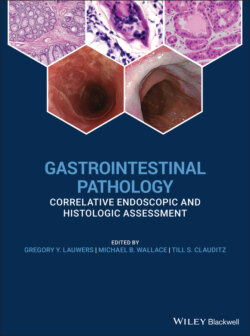Читать книгу Gastrointestinal Pathology - Группа авторов - Страница 46
Clinical Features and Endoscopic Characteristics
ОглавлениеClinical and endoscopic features are specific to each condition. For candidal esophagitis, symptoms vary from none (especially in patients with mild disease from chronic inhaled steroids) to severe dysphagia and odynophagia in immunosuppressed patients. Candida appears as a white, cottage cheese‐like exudate, which is partially adherent to the epithelium (Figure 2.3). HSV and CMV both cause ulcerations. HSV ulcers are typically small, 1–3 mm, whereas CMV ulcers may be both deep and wide. Biopsy yield for the virus is highest from the edge of HSV ulcers and from the center of CMV ulcers. In practice, both are usually obtained. Other infections’ etiologies may have nonspecific findings. The inflammatory reaction of tuberculous esophagitis often imparts a radiologically detectable mass‐like lesion, whereas mucosal changes include linear ulcers and induration that preferentially affects the mid‐portion of the esophagus. Fistula formation and perforation may occur. Chagas disease presentation is similar to that of achalasia with manometric findings of a poorly relaxing lower esophageal sphincter and an aperistaltic esophagus body.
Figure 2.3 Endoscopic appearance of white exudate typical of Candida albicans in a patient on chronic inhaled corticosteroid.
